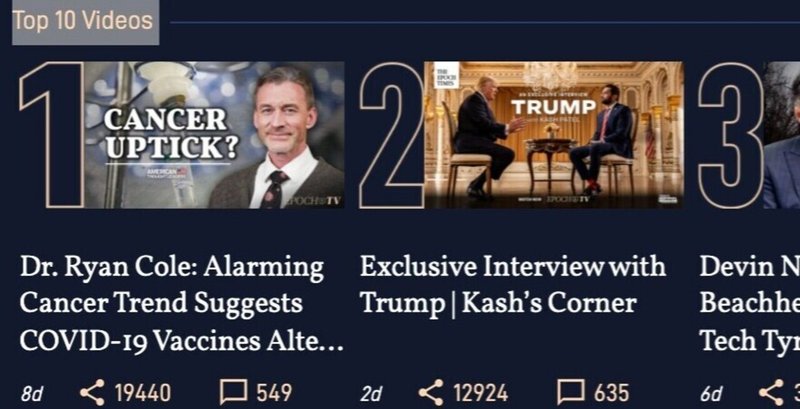
NTDで1位の動画-3/4:ライアン・コール医学博士 COVID-19ワクチンによる癌の発生傾向と、自然免疫反応の変化(+ビタミンDの重要性について) / (Dr. Ryan Cole):(Alarming Cancer Trend Suggests COVID-19 Vaccines Alter Natural Immune Response)
ヤン・ジェキエレク(インタビュアー、以下J): では、顕微鏡を通して、他にどんなパターンが見えてきたんですか?
ライアン・コール医学博士(以下コール博士):素晴らしい質問ですね。興味深いものでしたよ。私は(COVIDの)早期治療は、同僚達を手伝っていただけで、彼らほど治療数はありません。というのも、自分のラボの仕事が忙しかったので。だけど、例の注射が普及し始めた後から、かなりの量の皮膚生検の仕事をするようになったんですよ。そして、例の注射が普及し始めた後に気づいた事のは、通常は、子供にしか見られない、この小さなウイルス性のぶつぶつが(大人に)見られるようになった事です。これは、『伝染性軟属腫(水イボ)』と呼ばれるもので、パラポックスウイルスの一種です。パラポックスウイルスの一種で、通常は子供がかかるものなんです。伝染性軟属腫は伝染力が強いので、子供が小さいうちは何度もうつるからこの名前になりました。しかし、通常、双子や10代になる頃には、免疫システムがそれを抑えてくれるのです。
J:それを発症させた人たちはどうなっていると言えるのですか?
コール博士:そのウイルスは小さな皮膚のイボイボを引き起こすだけなんだ。ヒト乳頭腫ウイルス(HPV)ではありません。パップオキシウイルスですが、この小さな白いイボイボのようなものができるのです。興味深いのは、予防接種が始まったとき、まず年配の人たちから始めたのを覚えていますか?そのため、私は全国や地域の皮膚科医や家庭医から皮膚がんの生検をたくさん請け負っています。
そして、通常なら子供に見られるこの水イボが、高齢者に増えていることに気づき始めたのです。そして、「いや、これは珍しい。こんなことは見たことがない。これは高齢者ではなく、子どもの感染症だ」と思いました。その後、それは止まることを知らず、どんどん増えてきて、「これは何かの免疫異常だ」と思ったんです。そして、既に疑問を抱いていた例の実験的な薬品の使用のことを考えた。だって、その中の成分の一部がどういったものなのかも、どう作用するのかもわからなかったわけですから。
そして、私はその後も何千何万というCOVID関連の論文を読み、COVIDに執着していきました。それは、オンライン講義を聴講や、講義資料を読んだり、免疫反応について調べたり、誰かこのことについて書いていないかと探したりするということでした。 で、この水イボが出始めたのを見た。つまり、免疫異常を見て、「ヒューストン、問題が発生したぞ!(宇宙飛行士が、探索中に大きなトラブルに直面した時にヒューストン基地に呼びかけることで有名なセリフ)」と思ったのです。 なぜなら、です。(このトレンドを見つけた)その1〜2ヵ月後、突然、ある種の癌が(増加して)発生し始めました。 50万人もの患者(の生検)をラボで診てきた私ですから、よく目にする癌は分かります。そして、それだけの数を見ていると、その年ごとの大体のトレンドが分かってくるものです。
子宮内膜がんが増え始め、ある種のメラノーマ(皮膚癌)もふえはじめました。それも、早くて、分厚いものをね。 もちろん、私は(別の要因も)考えました。「これは、私たちがロックダウン(監禁)されて(外出が少なくて十分なビタミンDが生成できないで)いたからか、それとも、人々が医者に行かなくなったり、定期検診を逃していたからなのか? あるいは、人々が予防接種を受け出した時期と相関があるのだろうか?
たぶん、そのどれにも要因があるはずですが… (病院に行けていなかった事による影響の大きさを明白にするために)パンデミック時に閉鎖しなかった診療所と、閉鎖した診療所があることは分かっていましたから… そこで、統計分析と回帰分析を行い、(診療所間にあまり差が見られなかったことから)「なるほど、こういう病気が増えているんだな」と思いました。 同業者は批判するでしょう 「それは単なる事例証拠だろう」とね… でも、私は「その通りかもしれない。年間たった25,000人の患者さんの40,000回の生検をしているだけだから、全体を網羅するような統計は取れないよ。」と言えるでしょう。でも、少なくとも私はパターンを見ましたし、全ての科学は観察研究から始まるんです。
こういった事を指摘したんです。そして全国各地の講演会に招かれて話すうちに、興味深いことに、他の腫瘍専門医たちが私に声をかけてきたり、電話をかけてきたりするようになったのです。昨日も、ある放射線腫瘍医が私のところにやってきて、「あなたの言うとおりだ。何かが間違っている。私たちが通常治療で抑えられて管理できていた癌を、私も見ている!
通常なら(癌治療が終了した)患者さんは、その後 2年、3年、5年、6年と良い人生を送るんです。 だけど、(例の)ワクチンやそのブースターを打ったら、その2ヵ月後には山火事のように荒れ狂っているのです。そして、こういった癌は、今までなら簡単に管理できたタイプの癌なんです。」ってね。
何度も言いますが、病理学の専門医として、私は病態生理学的なメカニズムは何か、何が原因でこのような異常が起こっているのかをリサーチし始めました。 そして、オランダの Föhse(フォース)博士らによる、ファイザー社製ワクチンに関する非常に優れた論文を見つけました。
それは、注射後の免疫系をかなり詳細に分析したモノでした。その結論は、自然免疫反応の変化が見られるという意味で、憂慮すべきものであり、懸念すべきものでした。
続く…
Mr. Jekielek: So in terms of these patterns, what else have you seen looking through the microscope?
Dr. Cole: That’s a great question. And this was what was interesting. So pattern wise, yes, early treatments I saw with my colleagues and I didn’t treat a ton of patients, my colleagues treated a lot more than I. I helped where I could because I was busy in the lab. But in the lab, after the shots rolled out, so I do a fair amount of skin biopsy work.
And I noticed after the shots rolled out, there’s this little viral bump that I generally see in children. It’s called Molluscum contagiosum, it’s a parapoxvirus. And usually kids will get it. Contagiosum is the name because it’s pretty contagious and kids pass it back and forth when they’re little. But usually by the time you’re in your twins or teens, your immune system keeps it in check.
Mr. Jekielek: What does it do to people that have it?
Dr. Cole: Oh, that virus just causes little skin warty bumps. It’s not a human papilloma virus. It’s a papapoxyvirus, but it causes this little white warty bump. So the interesting thing was, okay, kids get that, when the shots rolled out, you remember how we rolled it out to the older age groups first? So I get a lot of skin cancer biopsies from the dermatologists and family doctors around the country and my region.
And I started noticing an uptick in this bump that I usually see in children in the elderly. And I thought, “Oh no, this is unusual. I never see this. This is an infection of childhood, not of the elderly.” And then I started seeing more and then more, and I thought, “Wait a minute, this is immune dysregulation of some sort.” And I had already had my concerns about using an experimental therapy, not knowing what certain ingredients were, not knowing what they would do.
And I, again, I had read thousands upon thousands of COVID paper, COVID was my obsession. Whether it was online lectures or reading lectures, looking at the immune responses, trying to find is anybody writing about this, et cetera. So I saw that bump. I saw that immune dysregulation, I thought, “Uh-Oh, Houston, we have a problem.” Because that line of cells, that line of T-cells that keeps viruses in check, that family of cells also keeps cancers in check. Well, at the same time, about a month or two later, all of a sudden there are certain types of cancers that I commonly see in the laboratory after 500,000 patients. You have an idea year to year over year what you’re seeing.
I started seeing endometrial cancers go up and there’s certain type… Melanomas, I started seeing thicker and earlier as well. And of course I thought, “Okay, is this because we’ve been locked down or is this because people aren’t going to their doctor, or are they missing their visits? Or is it correlating with a timeframe in which people are getting the shots?”
It was both, but I know which clinics never shut down during the pandemic, and I know which ones did. So I did a statistical analysis and regression, I thought, “Okay, I’m seeing an increase in these certain things.” Now my colleagues will criticize and say, “Well, that’s just anecdotal.” And I can say, “Yeah, you’re right. I only see 25,000 patients, 40,000 biopsies a year. You can’t do a complete statistic set on that.” But at least I saw the patterns and all science really starts with an observation.
And so I pointed this out. And then interestingly as I’ve been invited and talked at lectures around the country, other oncologists have come up to me or called me. Or even just yesterday, a radiation oncologist came up to me and said, “You’re right. Something is wrong. I am seeing cancers that we normally keep in check, and we know we can manage this cancer.
And the patient will get 2, 3, 5, 6 good years of life, but they got their shot or they got their booster, and then two months later, their cancer is a wildfire. And these are things that we’ve managed easily in the past.” So again, as a pathologist, I go to what’s the pathophysiologic mechanism, what’s causing this what’s going awry. And there was a really good paper by Dr. Föhse et al out of the Netherlands, looking at the Pfizer vaccines.
And they did a pretty good analysis of the immune system after the shots. And their conclusion was alarming and concerning in the sense that it said, we’re seeing an alteration of the innate immune response.
この記事が気に入ったらサポートをしてみませんか?
